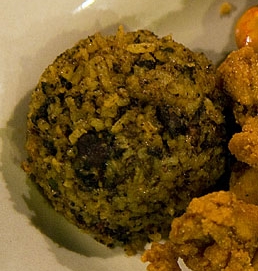Dirty rice
Dirty rice is a traditional Louisiana Creole dish made from white rice which gets a "dirty" color from being cooked with small pieces of chicken liver or giblets, which give it a distinctive flavor. Other ingredients include bell pepper, celery, onion, and spices such as cayenne pepper and black pepper.
Ingredients[edit | edit source]
The primary ingredients in dirty rice are:
- White rice
- Chicken liver or giblets
- Bell pepper
- Celery
- Onion
- Cayenne pepper
- Black pepper
- Garlic
- Parsley
- Green onions
Preparation[edit | edit source]
Dirty rice is typically prepared by first cooking the chicken liver or giblets until they are browned. These are then finely chopped and returned to the pan along with the holy trinity of Creole cooking: bell pepper, celery, and onion. Garlic and other seasonings are added, and the mixture is cooked until the vegetables are tender. The cooked rice is then added to the pan and mixed thoroughly to ensure that it absorbs the flavors of the meat and vegetables.
Variations[edit | edit source]
There are many variations of dirty rice, with some recipes including ground beef or pork sausage instead of or in addition to chicken liver. Some versions also include kidney beans or black-eyed peas.
Cultural Significance[edit | edit source]
Dirty rice is a staple in Louisiana cuisine and is often served as a side dish or as a main course. It is particularly popular during Mardi Gras and other celebrations. The dish reflects the resourcefulness of Creole cooks, who used every part of the chicken to create a flavorful and satisfying meal.
Related Dishes[edit | edit source]
See Also[edit | edit source]
References[edit | edit source]
External Links[edit | edit source]
Search WikiMD
Ad.Tired of being Overweight? Try W8MD's physician weight loss program.
Semaglutide (Ozempic / Wegovy and Tirzepatide (Mounjaro / Zepbound) available.
Advertise on WikiMD
|
WikiMD's Wellness Encyclopedia |
| Let Food Be Thy Medicine Medicine Thy Food - Hippocrates |
Translate this page: - East Asian
中文,
日本,
한국어,
South Asian
हिन्दी,
தமிழ்,
తెలుగు,
Urdu,
ಕನ್ನಡ,
Southeast Asian
Indonesian,
Vietnamese,
Thai,
မြန်မာဘာသာ,
বাংলা
European
español,
Deutsch,
français,
Greek,
português do Brasil,
polski,
română,
русский,
Nederlands,
norsk,
svenska,
suomi,
Italian
Middle Eastern & African
عربى,
Turkish,
Persian,
Hebrew,
Afrikaans,
isiZulu,
Kiswahili,
Other
Bulgarian,
Hungarian,
Czech,
Swedish,
മലയാളം,
मराठी,
ਪੰਜਾਬੀ,
ગુજરાતી,
Portuguese,
Ukrainian
Medical Disclaimer: WikiMD is not a substitute for professional medical advice. The information on WikiMD is provided as an information resource only, may be incorrect, outdated or misleading, and is not to be used or relied on for any diagnostic or treatment purposes. Please consult your health care provider before making any healthcare decisions or for guidance about a specific medical condition. WikiMD expressly disclaims responsibility, and shall have no liability, for any damages, loss, injury, or liability whatsoever suffered as a result of your reliance on the information contained in this site. By visiting this site you agree to the foregoing terms and conditions, which may from time to time be changed or supplemented by WikiMD. If you do not agree to the foregoing terms and conditions, you should not enter or use this site. See full disclaimer.
Credits:Most images are courtesy of Wikimedia commons, and templates, categories Wikipedia, licensed under CC BY SA or similar.
Contributors: Prab R. Tumpati, MD


